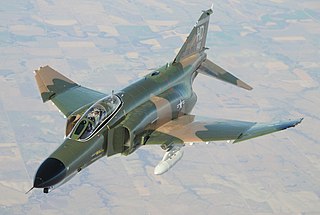
The McDonnell Douglas F-4 Phantom II is an American tandem two-seat, twin-engine, all-weather, long-range supersonic jet interceptor and fighter-bomber originally developed by McDonnell Aircraft for the United States Navy. Proving highly adaptable, it entered service with the Navy in 1961 before it was adopted by the United States Marine Corps and the United States Air Force, and by the mid-1960s it had become a major part of their air arms. Phantom production ran from 1958 to 1981 with a total of 5,195 aircraft built, making it the most produced American supersonic military aircraft in history, and cementing its position as a signature combat aircraft of the Cold War.
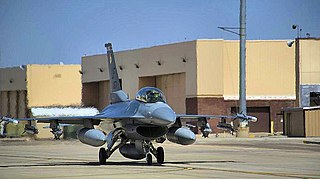
Holloman Air Force Base is a United States Air Force base established in 1942 located six miles (10 km) southwest of the central business district of Alamogordo, and a census-designated place in Otero County, New Mexico, United States. The base was named in honor of Col. George V. Holloman, a pioneer in guided missile research. It is the home of the 49th Wing of the Air Education and Training Command (AETC).

George Air Force Base was a United States Air Force base located within the city limits, 8 miles northwest, of central Victorville, California, about 75 miles northeast of Los Angeles, California.
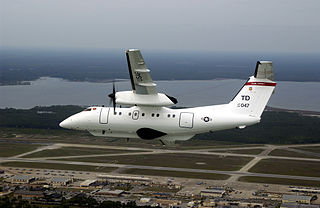
The 82nd Aerial Targets Squadron is a United States Air Force unit. It is assigned to the 53rd Weapons Evaluation Group and stationed at Tyndall Air Force Base, Florida.

The 35th Fighter Wing is an air combat unit of the United States Air Force and the host unit at Misawa Air Base, Japan. The wing is part of Pacific Air Forces (PACAF)'s Fifth Air Force.

F-4 Phantom II non-U.S. operators are the non-U.S. nations with air forces that operate or used to operate the McDonnell Douglas F-4 Phantom II. The Phantom II entered service with the U.S. military in 1960 and served until 1996. During this time it was the primary interceptor, air superiority fighter and fighter bomber with the U.S. Navy, Marines and Air Force.

The 8th Fighter Squadron is an active United States Air Force squadron, assigned to the 54th Fighter Group Air Education and Training Command, stationed at Holloman Air Force Base, New Mexico. It currently operates the General Dynamics F-16 Fighting Falcon aircraft, conducting initial training, transition and instructor upgrades training. The squadron have a proud lineage of aircraft and assignments. The origin of the 8th Fighter Squadron can be traced back to 1940, and since then, the squadron has served in several war and peace time assignments across the globe.

The 9th Attack Squadron is a United States Air Force squadron, assigned to the 49th Operations Group, stationed at Holloman Air Force Base, New Mexico. The squadron is a training unit for new pilots and sensor operators for the MQ-9 Reaper Remotely Piloted Aircraft (RPA).

The 21st Fighter Squadron is part of the 56th Operations Group at Luke Air Force Base, Arizona, however it is separately based at Morris Air National Guard Base. It is a United States Air Force squadron that operates Taiwan-owned General Dynamics F-16V Fighting Falcon aircraft conducting fighter and maintenance training for the pilots and maintainers of the Republic of China Air Force.

The 63d Fighter Squadron is an active United States Air Force unit, assigned to the 56th Operations Group, at Luke Air Force Base, Arizona. It operates the F-35A aircraft, and conducts advanced fighter training since its reactivation in 2016. When this Squadron was reactivated in 1975, their mission was to train pilots and weapons systems officers for the McDonnell F-4E Phantom II, and they switched to the F-4D in 1978.

The 69th Fighter Squadron is a United States Air Force Reserve fighter squadron. It is assigned to the 944th Operations Group, stationed at Luke Air Force Base, Arizona.
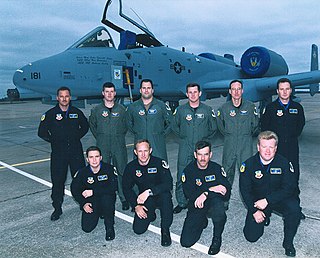
The 70th Fighter Squadron is an inactive United States Air Force squadron. The Squadron was constituted on 14 Dec 1940 as the 70th Pursuit Squadron (Interceptor). This squadron was activated on 1 Jan 1941 and patrolled the airspace around Fiji. After the war, the squadron was declared inactivated on 26 Dec 1945. The 70th Tactical Fighter Squadron was reinstated on 8 Sep 1975 and serve the 70th Fighter Squadron was retired on 1 Nov 1991. It was most recently part of the 347th Wing at Moody Air Force Base, Georgia. It operated Fairchild Republic A-10 Thunderbolt II aircraft conducting ground attack missions.

The 7th Fighter Squadron is an active United States Air Force unit, assigned to the 1st Operations Group. It is stationed at Langley Air Force Base, Virginia.

The 309th Fighter Squadron is part of the 56th Operations Group at Luke Air Force Base, Arizona. It operates the F-16 Fighting Falcon aircraft conducting advanced fighter training.

The 311th Fighter Squadron (Sidewinders) is part of the 54th Fighter Group at Holloman Air Force Base, New Mexico which is a geographically separated unit under the 56th Fighter Wing at Luke Air Force Base, Arizona. It operates the General Dynamics F-16 Fighting Falcon aircraft conducting advanced fighter training. The squadron previously operated the Fighting Falcon conducting advanced fighter training at Luke and was inactivated due to budget constraints after the end of the Cold War. It was recently reactivated at Holloman and the aircraft were received from the 309th Fighter Squadron.
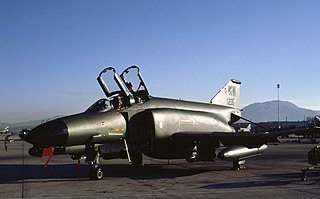
The 831st Air Division is an inactive United States Air Force organization. Its last assignment was with Tactical Air Command, assigned to Twelfth Air Force at George Air Force Base, California, where it was inactivated on 31 March 1991.
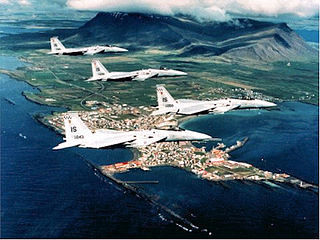
The 57th Fighter-Interceptor Squadron, also known as "The Black Knights of Keflavik", is an inactive United States Air Force unit. The 57 FIS was last stationed at Naval Air Station Keflavik, Iceland. It was inactivated on 1 March 1995.
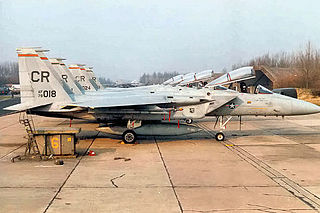
The 32nd Air Operations Squadron, nicknamed the Wolfhounds, is an inactive United States Air Force unit. Its last assignment was with 32nd Air Operations Group, based at Ramstein Air Base, Germany. It was inactivated on 1 November 2005. Between 1955 and 1994, the unit was based at Soesterberg Air Base in the Netherlands, providing air defence on behalf of NATO as a fighter squadron.

The 512th Fighter Squadron is an inactive United States Air Force unit. Its last assignment was with the 86th Fighter Wing at Ramstein Air Base, Germany, where it was inactivated September 1994.

The 313th Tactical Fighter Squadron is an inactive United States Air Force unit. It was last assigned to the 50th Tactical Fighter Wing and stationed at Hahn Air Base, Germany.



























